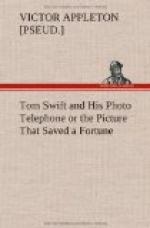“That’s my intention, But I can fix it so that a person can control the apparatus at his end, and only see the person he is talking to, not being seen himself, unless he wishes it. That is, I hope to do that. Just now nobody can see anybody,” and Tom sighed.
“Give it up,” advised Ned. “It’s too hard a nut to crack, Tom!”
“Indeed, I’ll not give it up, Ned! I’m going to work along a new line. I must try a different solution of selenium on the metal plate. Perhaps I may have to try using a sensitized plate, and develop it later, though I do want to get the machine down so you can see a perfect image without the need of developing. And I will, too!” cried Tom. “I’ll get some new selenium.”
Eradicate, who came into the shop just then, heard the end of Tom’s remarks. A strange look came over his honest black face, and he exclaimed:
“What all am dat, Massa Tom? Yo’ah gwine t’ bring de new millenium heah? Dat’s de end of de world, ain’t it-dat millenium? Golly! Dish yeah coon neber ‘spected t’ lib t’ see dat. De millenium! Oh mah landy!”
“No, Rad!” laughed Tom. “I was speaking about selenium, a sort of metallic combination that is a peculiar conductor of electricity. The more light that shines on it the better conductor it is, and the less light, the poorer.”
“It must be queer stuff,” said Ned.
“It is,” declared Tom. “I think it is the only thing to use in this photo telephone experiment, though I might try the metal plate method, as they did between Monte Carlo and Paris. But I am not trying to make newspaper pictures.”
“What is selenium, anyhow?” asked Ned. “Remember, Tom, I’m not up on this scientific stuff as you are.”
“Selenium,” went on Tom, “was discovered in 1817, by J. J. Berzelius, and he gave it that name from the Greek word for moon, on account of selenium being so similar, in some ways, to tellurium. That last is named after the Latin word tellus, the earth.”
“Do they dig it?” Ned wanted to know.
“Well, sometimes selenium is found in combination with metals, in the form of selenides, the more important minerals of that kind being eucharite, crooksite, clausthalite, naumannite and zorgite—”
“Good night!” interrupted Ned, with a laugh, holding up his hands. “Stop it, Tom!” he pleaded. “You’ll give me a headache with all those big words.”
“Oh, they’re easy, once you get used to them,” said the young inventor, with a smile. “Perhaps it will be easier if I say that sometimes selenium is found in native sulphur. Selenium is usually obtained from the flue-dust or chamber deposits of some factory where sulphuric acid is made. They take this dust and treat it with acids until they get the pure selenium. Sometimes selenium comes in crystal forms, and again it is combined with various metals for different uses.”
“There’s one good thing about it. There are several varieties, and I’ll try them all before I give up.”




